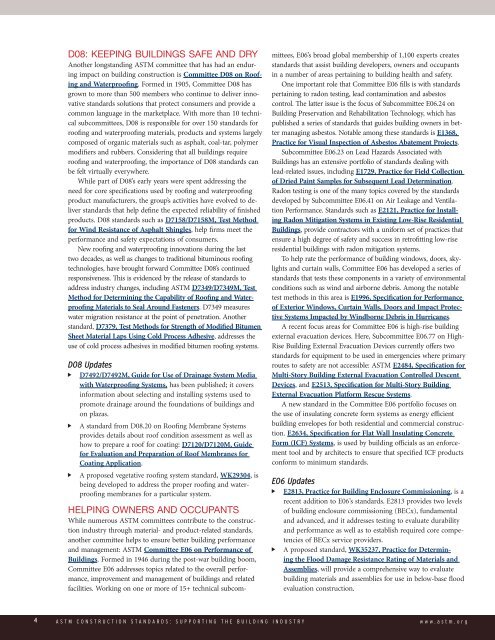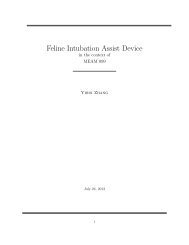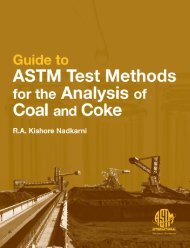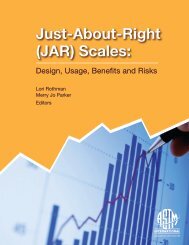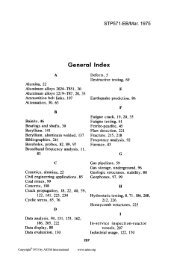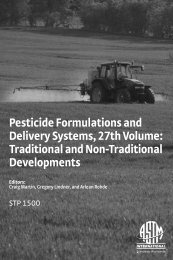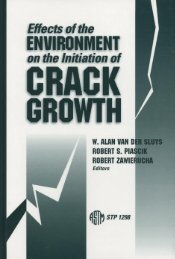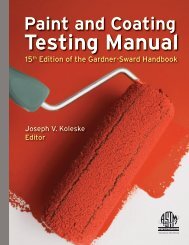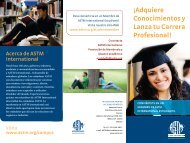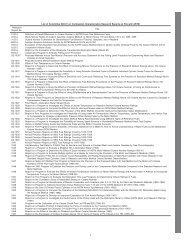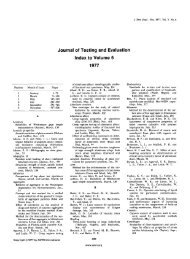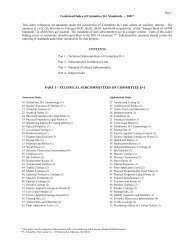ASTM Construction Standards: Supporting the Building Industry
ASTM Construction Standards: Supporting the Building Industry
ASTM Construction Standards: Supporting the Building Industry
You also want an ePaper? Increase the reach of your titles
YUMPU automatically turns print PDFs into web optimized ePapers that Google loves.
4<br />
d08: KeePIng buILdIngS SAFe And dry<br />
Ano<strong>the</strong>r longstanding <strong>ASTM</strong> committee that has had an enduring<br />
impact on building construction is Committee D08 on Roofing<br />
and Waterproofing. Formed in 1905, Committee D08 has<br />
grown to more than 500 members who continue to deliver innovative<br />
standards solutions that protect consumers and provide a<br />
common language in <strong>the</strong> marketplace. With more than 10 technical<br />
subcommittees, D08 is responsible for over 150 standards for<br />
roofing and waterproofing materials, products and systems largely<br />
composed of organic materials such as asphalt, coal-tar, polymer<br />
modifiers and rubbers. Considering that all buildings require<br />
roofing and waterproofing, <strong>the</strong> importance of D08 standards can<br />
be felt virtually everywhere.<br />
While part of D08’s early years were spent addressing <strong>the</strong><br />
need for core specifications used by roofing and waterproofing<br />
product manufacturers, <strong>the</strong> group’s activities have evolved to deliver<br />
standards that help define <strong>the</strong> expected reliability of finished<br />
products. D08 standards such as D7158/D7158M, Test Method<br />
for Wind Resistance of Asphalt Shingles, help firms meet <strong>the</strong><br />
performance and safety expectations of consumers.<br />
New roofing and waterproofing innovations during <strong>the</strong> last<br />
two decades, as well as changes to traditional bituminous roofing<br />
technologies, have brought forward Committee D08’s continued<br />
responsiveness. This is evidenced by <strong>the</strong> release of standards to<br />
address industry changes, including <strong>ASTM</strong> D7349/D7349M, Test<br />
Method for Determining <strong>the</strong> Capability of Roofing and Waterproofing<br />
Materials to Seal Around Fasteners. D7349 measures<br />
water migration resistance at <strong>the</strong> point of penetration. Ano<strong>the</strong>r<br />
standard, D7379, Test Methods for Strength of Modified Bitumen<br />
Sheet Material Laps Using Cold Process Adhesive, addresses <strong>the</strong><br />
use of cold process adhesives in modified bitumen roofing systems.<br />
D08 Updates<br />
k D7492/D7492M, Guide for Use of Drainage System Media<br />
with Waterproofing Systems, has been published; it covers<br />
information about selecting and installing systems used to<br />
promote drainage around <strong>the</strong> foundations of buildings and<br />
on plazas.<br />
k A standard from D08.20 on Roofing Membrane Systems<br />
provides details about roof condition assessment as well as<br />
how to prepare a roof for coating: D7120/D7120M, Guide<br />
for Evaluation and Preparation of Roof Membranes for<br />
Coating Application.<br />
k A proposed vegetative roofing system standard, WK29304, is<br />
being developed to address <strong>the</strong> proper roofing and waterproofing<br />
membranes for a particular system.<br />
heLPIng ownerS And oCCuPAnTS<br />
While numerous <strong>ASTM</strong> committees contribute to <strong>the</strong> construction<br />
industry through material- and product-related standards,<br />
ano<strong>the</strong>r committee helps to ensure better building performance<br />
and management: <strong>ASTM</strong> Committee E06 on Performance of<br />
<strong>Building</strong>s. Formed in 1946 during <strong>the</strong> post-war building boom,<br />
Committee E06 addresses topics related to <strong>the</strong> overall performance,<br />
improvement and management of buildings and related<br />
facilities. Working on one or more of 15+ technical subcom-<br />
mittees, E06’s broad global membership of 1,100 experts creates<br />
standards that assist building developers, owners and occupants<br />
in a number of areas pertaining to building health and safety.<br />
One important role that Committee E06 fills is with standards<br />
pertaining to radon testing, lead contamination and asbestos<br />
control. The latter issue is <strong>the</strong> focus of Subcommittee E06.24 on<br />
<strong>Building</strong> Preservation and Rehabilitation Technology, which has<br />
published a series of standards that guides building owners in better<br />
managing asbestos. Notable among <strong>the</strong>se standards is E1368,<br />
Practice for Visual Inspection of Asbestos Abatement Projects.<br />
Subcommittee E06.23 on Lead Hazards Associated with<br />
<strong>Building</strong>s has an extensive portfolio of standards dealing with<br />
lead-related issues, including E1729, Practice for Field Collection<br />
of Dried Paint Samples for Subsequent Lead Determination.<br />
Radon testing is one of <strong>the</strong> many topics covered by <strong>the</strong> standards<br />
developed by Subcommittee E06.41 on Air Leakage and Ventilation<br />
Performance. <strong>Standards</strong> such as E2121, Practice for Installing<br />
Radon Mitigation Systems in Existing Low-Rise Residential<br />
<strong>Building</strong>s, provide contractors with a uniform set of practices that<br />
ensure a high degree of safety and success in retrofitting low-rise<br />
residential buildings with radon mitigation systems.<br />
To help rate <strong>the</strong> performance of building windows, doors, skylights<br />
and curtain walls, Committee E06 has developed a series of<br />
standards that tests <strong>the</strong>se components in a variety of environmental<br />
conditions such as wind and airborne debris. Among <strong>the</strong> notable<br />
test methods in this area is E1996, Specification for Performance<br />
of Exterior Windows, Curtain Walls, Doors and Impact Protective<br />
Systems Impacted by Windborne Debris in Hurricanes.<br />
A recent focus areas for Committee E06 is high-rise building<br />
external evacuation devices. Here, Subcommittee E06.77 on High-<br />
Rise <strong>Building</strong> External Evacuation Devices currently offers two<br />
standards for equipment to be used in emergencies where primary<br />
routes to safety are not accessible: <strong>ASTM</strong> E2484, Specification for<br />
Multi-Story <strong>Building</strong> External Evacuation Controlled Descent<br />
Devices, and E2513, Specification for Multi-Story <strong>Building</strong><br />
External Evacuation Platform Rescue Systems.<br />
A new standard in <strong>the</strong> Committee E06 portfolio focuses on<br />
<strong>the</strong> use of insulating concrete form systems as energy efficient<br />
building envelopes for both residential and commercial construction.<br />
E2634, Specification for Flat Wall Insulating Concrete<br />
Form (ICF) Systems, is used by building officials as an enforcement<br />
tool and by architects to ensure that specified ICF products<br />
conform to minimum standards.<br />
E06 Updates<br />
k E2813, Practice for <strong>Building</strong> Enclosure Commissioning, is a<br />
recent addition to E06’s standards. E2813 provides two levels<br />
of building enclosure commissioning (BECx), fundamental<br />
and advanced, and it addresses testing to evaluate durability<br />
and performance as well as to establish required core competencies<br />
of BECx service providers.<br />
k A proposed standard, WK35237, Practice for Determining<br />
<strong>the</strong> Flood Damage Resistance Rating of Materials and<br />
Assemblies, will provide a comprehensive way to evaluate<br />
building materials and assemblies for use in below-base flood<br />
evaluation construction.<br />
<strong>ASTM</strong> ConSTruCTion STAndArdS: SupporTing The <strong>Building</strong> induSTry www.astm.org


